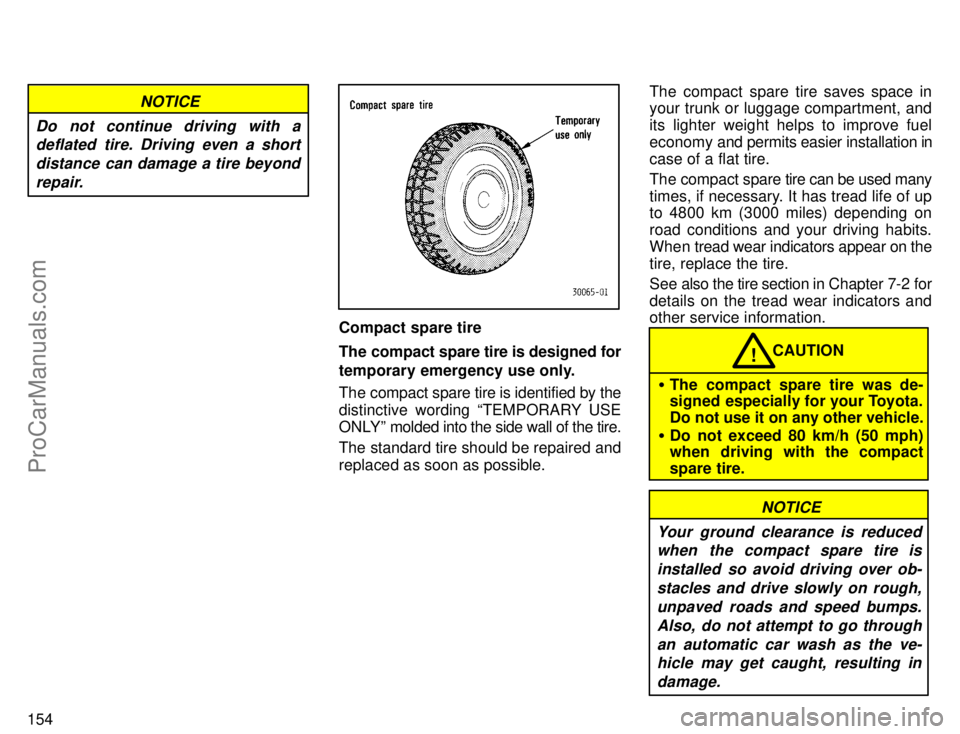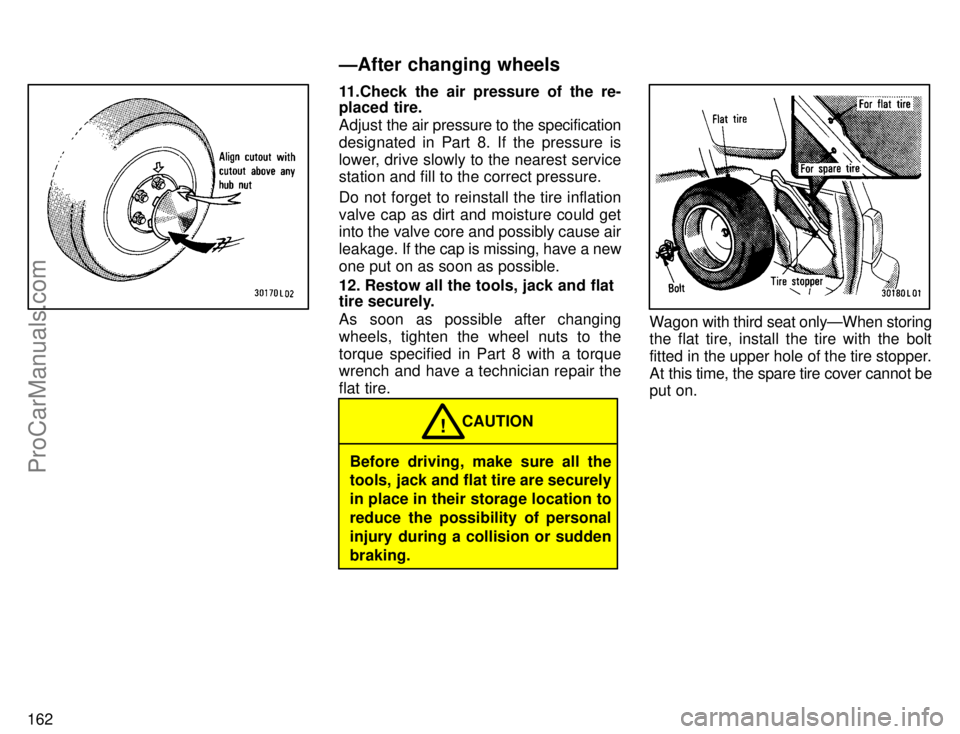Page 160 of 226

154
NOTICE
Do not continue driving with a
deflated tire. Driving even a short
distance can damage a tire beyond
repair.
Compact spare tire
The compact spare tire is designed for
temporary emergency use only.
The compact spare tire is identified by the
distinctive wording TEMPORARY USE
ONLYº molded into the side wall of the tire.
The standard tire should be repaired and
replaced as soon as possible.The compact spare tire saves space in
your trunk or luggage compartment, and
its lighter weight helps to improve fuel
economy and permits easier installation in
case of a flat tire.
The compact spare tire can be used many
times, if necessary. It has tread life of up
to 4800 km (3000 miles) depending on
road conditions and your driving habits.
When tread wear indicators appear on the
tire, replace the tire.
See also the tire section in Chapter 7-2 for
details on the tread wear indicators and
other service information.
�The compact spare tire was de-
signed especially for your Toyota.
Do not use it on any other vehicle.
�Do not exceed 80 km/h (50 mph)
when driving with the compact
spare tire.CAUTION
!
NOTICE
Your ground clearance is reduced
when the compact spare tire is
installed so avoid driving over ob-
stacles and drive slowly on rough,
unpaved roads and speed bumps.
Also, do not attempt to go through
an automatic car wash as the ve-
hicle may get caught, resulting in
damage.
ProCarManuals.com
Page 161 of 226
155
1. Get the tool bag, jack and spare tire.
To prepare yourself for an emergency,
you should familiarize yourself with the
use of the jack, each of the tools and their
storage locations.When removing the jack, turn the joint by
hand towards the CONTRACT direction
until the jack is free. When storing, turn
the joint by hand towards the EXPAND di-
rection until the jack is firmly secured to
prevent it from flying forward during a col-
lision or sudden braking.To remove the spare tire:
1. Loosen the nut and remove it.
2. Remove the spare tire cover.
3. Loosen and remove the bolt and
spacer.
4. Take the spare tire out of the vehicle.
When storing the spare tire, put it in place
with the outer side of the wheel facing up.
Then secure the tire by repeating the
above removal steps in reverse order to
prevent it from flying forward during a col-
lision or sudden braking.
ÐRequired tools and spare
tire (sedan and coupe)
ProCarManuals.com
Page 162 of 226
156
1. Get the tool bag, jack and spare tire.
To prepare yourself for an emergency,
you should familiarize yourself with the
use of the jack, each of the tools and their
storage locations.When removing the jack, turn the joint by
hand towards the CONTRACT direction
until the jack is free. When storing, turn
the joint by hand towards the EXPAND di-
rection until the jack is firmly secured to
prevent it from flying forward during a col-
lision or sudden braking.To remove the spare tire:
1. Loosen the nut and remove it.
2. Remove the spare tire cover.
ÐRequired tools and spare
tire (wagon with third seat)
ProCarManuals.com
Page 163 of 226
157
3. Loosen and remove the bolt.
4. Take the spare tire out of the vehicle.
When storing the spare tire, put it in place
with the inner side of the wheel facing in-
ward. Then secure the tire by repeating
the above removal steps in reverse order
to prevent it from flying forward during a
collision or sudden braking.1. Get the tool bag, jack and spare tire.
To prepare yourself for an emergency,
you should familiarize yourself with the
use of the jack, each of the tools and their
storage locations.When removing the jack, turn the joint by
hand towards the CONTRACT direction
until the jack is free. When storing, turn
the joint by hand towards the EXPAND di-
rection until the jack is firmly secured to
prevent it from flying forward during a col-
lision or sudden braking.
ÐRequired tools and spare tire
(wagon without third seat)
ProCarManuals.com
Page 164 of 226
158
To remove the spare tire:
1. Loosen and remove the bolt and
spacer.
2. Take the spare tire out of the vehicle.
When storing the spare tire, put it in place
with the outer side of the wheel facing up.
Then secure the tire by repeating the
above removal steps in reverse order to
prevent it from flying forward during a col-
lision or sudden braking.2. Block the wheel diagonally oppo-
site the flat tire to keep the vehicle from
rolling when it is jacked up.
When blocking the wheel, place a wheel
block from the front for the front wheels or
from the rear for the rear wheels.3. Remove the wheel ornament.
Pry off the wheel ornament, using the bev-
eled end of the wheel nut wrench as
shown.
Do not try to pull off the ornament
by hand. Take due care in handling
the ornament to avoid unexpected
personal injury.CAUTION
! ÐRemoving wheel ornament ÐBlocking the wheel
ProCarManuals.com
Page 166 of 226

160
6. After making sure that no one is in
the vehicle, raise it high enough so
that the spare tire can be installed.
Remember you will need more ground
clearance when putting on the spare tire
than when removing the flat tire.
To raise the vehicle, insert the jack handle
into the jack (it is a loose fit) and turn it
clockwise. As the jack touches the vehicle
and begins to lift, double-check that it is
properly positioned.
Never get under the vehicle when it
is supported by the jack alone.CAUTION
!
7. Remove the wheel nuts and change
tires.
Lift the flat tire straight off and put it aside.
Roll the spare wheel into position and
align the holes in the wheel with the bolts.
Then lift up the wheel and get at least the
top bolt started through its hole. Wiggle
the tire and press it back over the other
bolts.Before putting on wheels, remove any
corrosion on the mounting surfaces with a
wire brush or such. Installation of wheels
without good metal-to-metal contact at
the mounting surface can cause wheel
nuts to loosen and eventually cause a
wheel to come off while driving. Therefore
after the first 1600 km (1000 miles), check
to see that the wheel nuts are tight.
ÐChanging wheels ÐRaising your vehicle
ProCarManuals.com
Page 168 of 226

162
11.Check the air pressure of the re-
placed tire.
Adjust the air pressure to the specification
designated in Part 8. If the pressure is
lower, drive slowly to the nearest service
station and fill to the correct pressure.
Do not forget to reinstall the tire inflation
valve cap as dirt and moisture could get
into the valve core and possibly cause air
leakage. If the cap is missing, have a new
one put on as soon as possible.
12. Restow all the tools, jack and flat
tire securely.
As soon as possible after changing
wheels, tighten the wheel nuts to the
torque specified in Part 8 with a torque
wrench and have a technician repair the
flat tire.
Before driving, make sure all the
tools, jack and flat tire are securely
in place in their storage location to
reduce the possibility of personal
injury during a collision or sudden
braking.CAUTION
!
Wagon with third seat onlyÐWhen storing
the flat tire, install the tire with the bolt
fitted in the upper hole of the tire stopper.
At this time, the spare tire cover cannot be
put on.
ÐAfter changing wheels
ProCarManuals.com
Page 195 of 226

189 Clean all dirt from outside of the reservoir
tank and look at the fluid level. If the fluid
is cold, the level should be in the COLDº
range. Similarly, if it is hot, the fluid level
should be in the HOTº range. If the level
is at the low side of either range, add auto-
matic transmission fluid DEXRON
[-II or
-III to bring the level within the range.
To remove the filler cap, turn it counter-
clockwise and lift up. To reinstall it, turn it
clockwise. After replacing the filler cap,
visually check the steering box case, vane
pump and hose connections for leaks or
damage.
CAUTION!
The reservoir tank may be hot so be
careful not to burn yourself.
NOTICE
Avoid overfilling, or the power
steering could be damaged.
Keep your tire pressures at the proper
level.
The recommended cold tire pressures,
tire size and the vehicle capacity weight
are given in Part 8. They are also on the
tire pressure label inside the glove box lid.
You should check the tire pressures every
two weeks, or at least once a month. And
don't forget the spare!
Incorrect tire pressure can reduce tire
life and make your vehicle less safe to
drive.Low tire pressure results in excessive
wear, poor handling, reduced fuel econo-
my, and the possibility of blowouts from
overheated tires. Also, low tire pressure
can cause poor sealing of the tire bead. If
the tire pressure is excessively low, there
is the possibility of wheel deformation
and/or tire separation.
High tire pressure produces a harsh ride,
handling problems, excessive wear at the
center of the tire tread, and a greater pos-
sibility of tire damage from road hazards.
If a tire frequently needs refilling, have it
checked by your Toyota dealer.
The following instructions for check-
ing tire pressure should be observed:
�The pressure should be checked
only when the tires are cold. If your
vehicle has been parked for at least 3
hours and has not been driven for
more than 1.5 km or 1 mile since, you
will get an accurate cold tire pressure
reading.
�Always use a tire pressure gauge.
The appearance of a tire can be mis-
leading. Besides, tire pressures that
are even just a few pounds off can de-
grade handling and ride.
Checking tire pressure
ProCarManuals.com